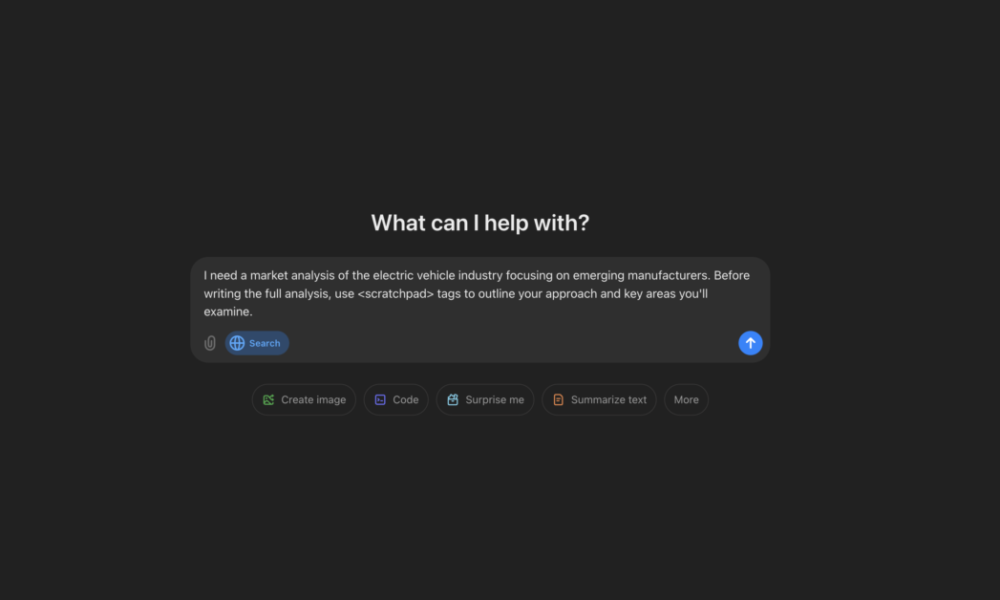The scratchpad technique fundamentally changes how we interact with Large Language Models (LLMs). Unlike traditional prompting where we simply state our request and hope for the best, the scratchpad technique creates a structured thought process that both you and the LLM can follow.
Consider this common scenario: When asking an LLM to analyze customer purchase patterns, a typical prompt might simply request the analysis directly. The result? Often a rushed or misaligned response that misses key considerations. Here’s where the scratchpad technique proves transformative.
Instead of diving straight into the solution, the scratchpad technique introduces a critical planning phase. By using <scratchpad> tags, you create a space where the LLM can:
- Map out its approach before execution
- Break down complex problems into manageable components
- Identify potential pitfalls early
- Allow for course correction before investing time in the wrong direction
The real power lies in transparency. When you can see how the LLM plans to tackle your request, you can catch misunderstandings immediately and guide it toward your intended outcome.
Building Your First Scratchpad
The basic structure of a scratchpad prompt consists of three key elements:
- The Initial Request: Present your task clearly, but don’t stop there. Include context about your goals and any specific requirements.
- The Scratchpad Directive:Direct the LLM to plan its approach using <scratchpad> tags. Be specific about what you want to see in the planning phase.
- The Review Loop: Examine the proposed approach and refine as needed before proceeding with the full response.
Let’s walk through a practical example. Rather than simply requesting a market analysis, here’s how you can structure it:
A basic scratchpad response will look something like this:

This planning stage reveals the LLM’s intended focus areas. If you notice it’s missing crucial elements – perhaps battery technology innovation or charging infrastructure partnerships – you can redirect before receiving a complete but off-target analysis.
Common Pitfalls to Avoid
- Vague Planning Directives: Don’t just ask the LLM to “plan its approach.” Request specific elements you want to see in the scratchpad, such as methodology, data points, or analytical frameworks.
- Skipping the Review Step: The scratchpad isn’t just for show – it’s your opportunity to course-correct. Take time to evaluate if the proposed approach aligns with your needs.
- Insufficient Context: While the scratchpad helps organize thinking, it can’t compensate for unclear initial requirements. Be specific about your needs, audience, and intended use of the information.
Beyond the Basics
When tackling LLM projects, crafting the right initial prompt becomes crucial.
Here are some prompt ideas for multi-layered challenges. Remember to include as much context in the form of attached documents or text as possible:
Product Launch Strategy Prompt:
- “I need to develop a comprehensive product launch strategy. Using <scratchpad> tags, break down your approach for analyzing market positioning, competitive landscape, and go-to-market planning. Consider potential information gaps and dependencies between these elements before providing any recommendations.”
Budget Planning Prompt:
- “Help me create a departmental budget for next year. Before providing numbers, use <scratchpad> tags to outline your methodology for considering historical data, growth projections, and resource allocation. Flag any assumptions you’ll need to make in this process.”
Project Risk Assessment Prompt:
- “We’re launching a new enterprise software system. Before listing potential risks, use <scratchpad> tags to map out how you’ll approach risk identification across technical, operational, and business dimensions. Include your framework for prioritizing these risks.”
Each of these prompts:
- Clearly states the end goal
- Requests specific planning elements
- Identifies key areas requiring consideration
- Encourages systematic thinking before solution generation
Note: These prompts are fairly simple examples. You can get very detailed and complex depending on the use case.
The key is being explicit about wanting to see the planning process before getting solutions. This prevents rushed responses and ensures thorough consideration of all relevant factors.
As mentioned, these prompts can (and should) be further customized by:
- Adding specific industry context
- Including known constraints
- Specifying required outputs
- Mentioning particular methodologies you want to be considered
Remember: The more complex the task, the more important it becomes to see the LLM’s planned approach before it generates solutions.
Advance Your Prompt Engineering Skill Through <scratchpad>

Learn <scratchpad> Prompting →
The scratchpad technique helps us transform the interaction between humans and LLMs. By implementing this structured approach, organizations and professionals can move beyond simple prompt-response patterns to achieve more sophisticated, reliable outcomes. This methodology proves particularly valuable in environments where accuracy, consistency, and transparent reasoning are paramount to decision-making processes.




